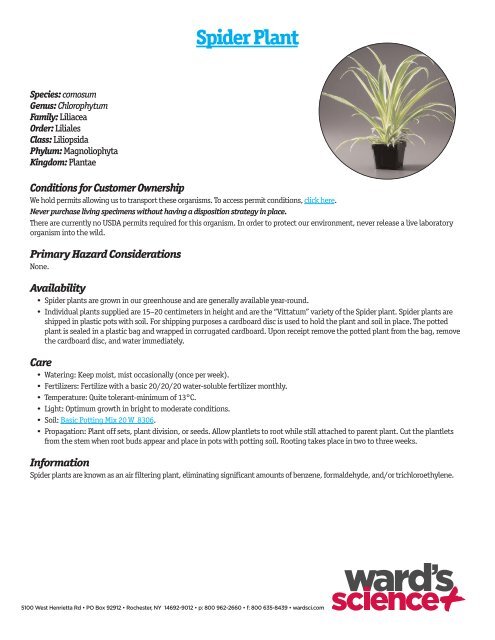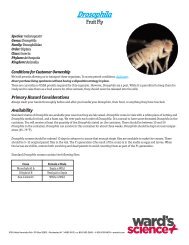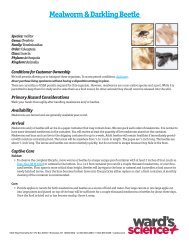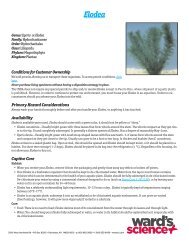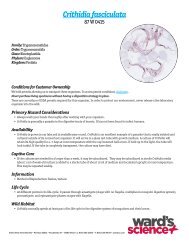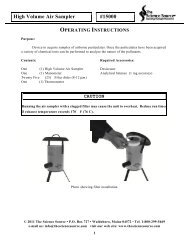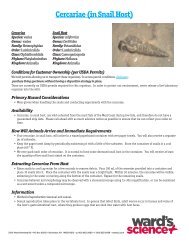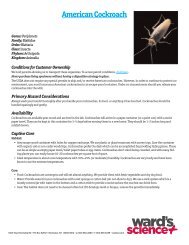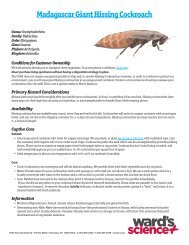Spider Plant - Sargent Welch
Spider Plant - Sargent Welch
Spider Plant - Sargent Welch
Create successful ePaper yourself
Turn your PDF publications into a flip-book with our unique Google optimized e-Paper software.
<strong>Spider</strong> <strong>Plant</strong><br />
Species: comosum<br />
Genus: Chlorophytum<br />
Family: Liliacea<br />
Order: Liliales<br />
Class: Liliopsida<br />
Phylum: Magnoliophyta<br />
Kingdom: <strong>Plant</strong>ae<br />
Conditions for Customer Ownership<br />
We hold permits allowing us to transport these organisms. To access permit conditions, click here.<br />
Never purchase living specimens without having a disposition strategy in place.<br />
There are currently no USDA permits required for this organism. In order to protect our environment, never release a live laboratory<br />
organism into the wild.<br />
Primary Hazard Considerations<br />
None.<br />
Availability<br />
• <strong>Spider</strong> plants are grown in our greenhouse and are generally available year-round.<br />
• Individual plants supplied are 15–20 centimeters in height and are the “Vittatum” variety of the <strong>Spider</strong> plant. <strong>Spider</strong> plants are<br />
shipped in plastic pots with soil. For shipping purposes a cardboard disc is used to hold the plant and soil in place. The potted<br />
plant is sealed in a plastic bag and wrapped in corrugated cardboard. Upon receipt remove the potted plant from the bag, remove<br />
the cardboard disc, and water immediately.<br />
Care<br />
• Watering: Keep moist, mist occasionally (once per week).<br />
• Fertilizers: Fertilize with a basic 20/20/20 water-soluble fertilizer monthly.<br />
• Temperature: Quite tolerant-minimum of 13°C.<br />
• Light: Optimum growth in bright to moderate conditions.<br />
• Soil: Basic Potting Mix 20 W 8306.<br />
• Propagation: <strong>Plant</strong> off sets, plant division, or seeds. Allow plantlets to root while still attached to parent plant. Cut the plantlets<br />
from the stem when root buds appear and place in pots with potting soil. Rooting takes place in two to three weeks.<br />
Information<br />
<strong>Spider</strong> plants are known as an air filtering plant, eliminating significant amounts of benzene, formaldehyde, and/or trichloroethylene.
Life Cycle<br />
Monocotyledon. Chlorophytum comosum is a clump-forming perennial with lance shaped leaves that grow to approximately<br />
30 centimeters in length. The plant has green leaves with cream or white center stripes. The rhizomatous root is thick and white and<br />
as it grows, it may actually force the plant out of its pot. Chlorophytum throw off long racemes with small six petalled flowers that eventually<br />
turn into plantlets. If the flowers are pollinated, seedpods can be produced. <strong>Spider</strong> plants will live for years with the proper care.<br />
Wild Habitat<br />
Chlorophytum is a genus of approximately 250 species. The cultivated variety of the <strong>Spider</strong> plant originated in South and West Africa.<br />
Disposition<br />
We do not recommend releasing any laboratory specimen into the wild, and especially not specimens that are not native to the<br />
environment. When finished with your plant please dispose of it by incineration in a well-ventilated area.<br />
© 2008 Ward’ s Science. All rights reserved. Rev. 9/08, 11/09, 3/13


